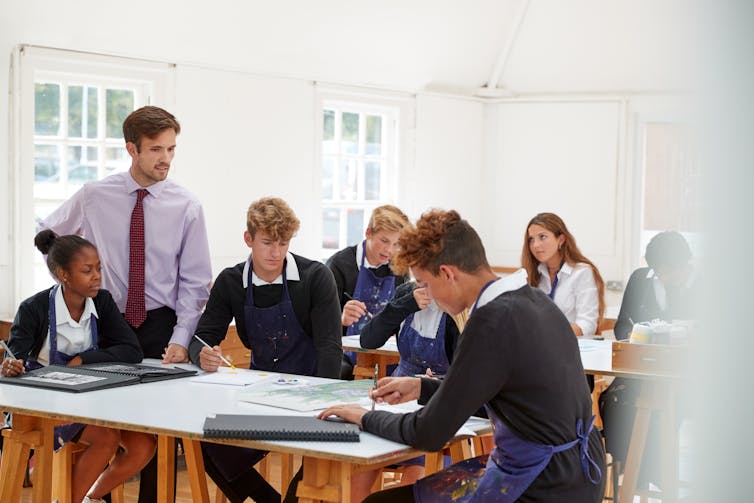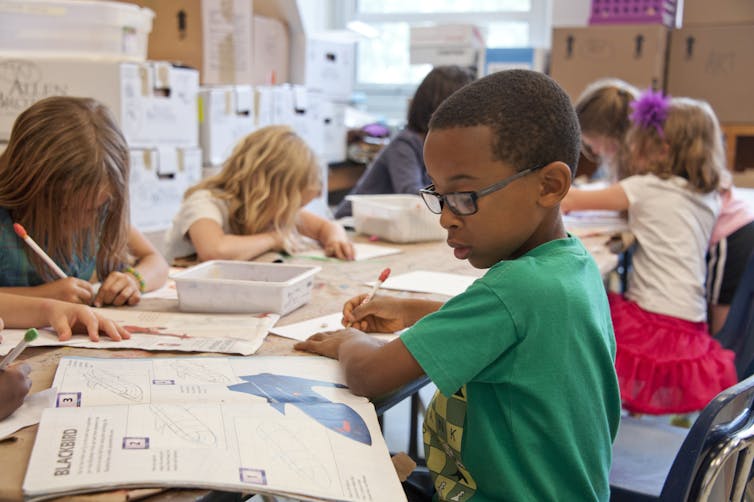It is not uncommon for kids to complain about school, but studies show significant numbers of Australian students are actually disengaged with their education.
A 2017 Grattan Institute report found as many as 40% are unproductive in a given year because they are disengaged.
This is a huge concern. Not being engaged can lead to issues with learning, behaviour, attendance and dropping out.
We know the disruptions of COVID and school closures have only increased the risks of student disengagement.
One answer could be “personalised learning”. Proponents of this approach say it allows students to engage more with what and how they learn at school. Although critics are not convinced.
My research with Australian teachers trialling personalised learning suggests it “makes sense”. But we need to think carefully about how it is rolled out.
What is personalised learning?
Personalised learning is an educational approach that aims to customise learning for each student’s strengths, needs and interests

In the United States, most states use personalised learning in some form. Tech moguls Bill Gates and Mark Zuckerberg have also donated millions to research on the approach.
The United Kingdom, Finland and New Zealand are also exploring personalised learning for their school systems.
Personalised learning in Australia
Australia is also looking at personalised learning. The 2012 Gonski report talked of the importance of “personalised learning strategies” to improve school outcomes.
ACT government policy now explicitly states:
the ACT education system of the future will be personalised to each child.
Other jurisdictions are also looking at how personalised learning can be implemented. Last year, NSW said it would trial “untimed syllabusses”, so students move through school at their own pace.
Personalised learning is not without its critics. Some educators say it isolates kids and risks an over-reliance on technology as a teaching tool. But this very much depends on how personalised instruction is implemented.
What does this look like in practice?
Under personalised learning, the existing curriculum is tailored to each student’s interests and needs. Students also have a say in how and what they learn.
For example, a history teacher allows students to pick their own project to work out how the past influences the present.
The teacher helps them frame the research questions and makes sure they are accessing relevant and robust data. But it is the students who are directing the project, be it about civil rights and Black Lives Matter, women’s liberation and #MeToo or the history of how computer games have been developed and marketed.

During a research trip to the US this year, I visited five schools in Vermont where I saw three key ways of personalising learning and culturally responsive teaching.
1. Personalised learning portfolios
These are used to gather information about students’ strengths, needs, passions, interests, and identities. This enables teachers to know their students well to design projects that fit with the students’ interest and abilities.
2. Flexibility
Teachers are flexible about both how students learn and the time and pace they do it in. They do projects instead of essays where they research topics they are interested in or they connect with communities to extend their knowledge about real-life matters.
The focus is on skills such as critical thinking, collaborative learning, communication, cultural understanding, and social action. For example, in one high school I visited, children worked with local farmers to help them resolve food waste issues, with teachers providing necessary guidance.
Read more: Why the curriculum should be based on students' readiness, not their age
3. Different ways of assessment
Assessment is not grade based (where students in the same year level are compared) but proficiency based. This looks at whether students are learning and whether they are meeting a certain standard. It also allows students to be involved. In a “student-led conference,” students update each other on what they have learned.
US students who had done personalised learning told colleagues and I this self-paced approach was relaxed and less stressful. It allowed them to be themselves and they felt like their opinions and choices were respected.
But there are challenges
Personalised learning will take time to roll out in schools and communities, given it is so different from the mass education approach teachers, parents and students are used to.
Colleagues and I are studying three ACT schools where teachers are trialling personalised learning. Our initial findings shed light on the challenges of implementing personalised learning. As one high school teacher told us:
Personalised learning makes sense […] particularly at the moment I have a class where one half is really hard working, and the other half for whatever reason, they just are not interested in work at all.
But another teacher said it was difficult to get their students interested in a different approach to learning.
I think, probably personalising is easier with primary students. I’m trying to implement my personal reading project in my high school, but it’s looking harder.
While noting the benefits, teachers are also wary of what this might mean for their (already significant) workloads.
So each and every student, we have to cater to their learning and that is why I feel that personalised learning helps them, you know, grasp the concepts. But isn’t this a lot of work for teachers?
The future of school?
Personalised learning is not a magic wand, but it has to potential to prepare learners who are self-regulating and self-motivated for life beyond school.
However, it is a paradigm shift for many schools, teachers, parents, and communities.
Moving forward, a key obstacle to overcome will be assuring already overworked teachers it will not lead to more work and educating parents about the potential benefits for their children.

